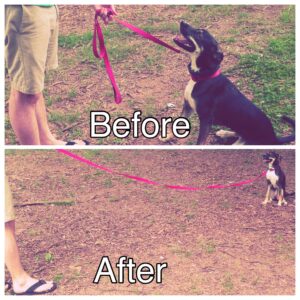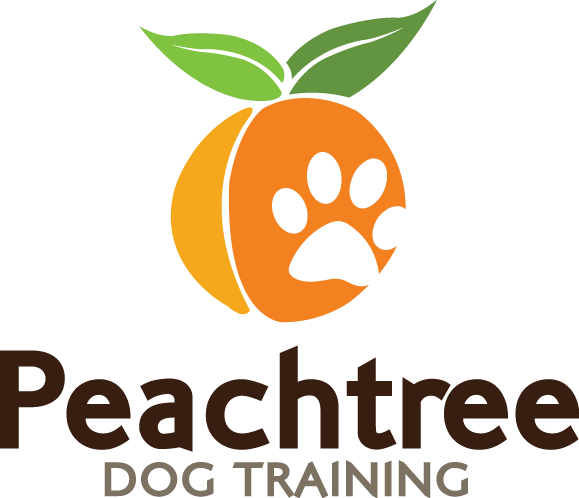The Three D’s: Distance, Duration, and Distraction
Before I became a professional dog trainer here in Atlanta, I worked at a doggie daycare as a kennel technician. I learned a lot from this job, finding myself asking more questions about dog behavior and training. I met many dogs and spoke with their owners at the end of the day, after I would bring them up to the lobby for pick up time. Many dogs at the daycare had gone through some training with a professional before, and in different styles (group classes, private in-home training, board and train, etc). With some of these dogs, their skills shined out—excellent recall with commands, good manners with strangers, walking well on the leash, and so forth. Of course, there were a couple of dogs that needed a little brush up on their dog training Atlanta style skills.

Gus’s focus remains strong, both on a 5ft leash and a 50ft leash! This is a great way to build reliability!
During this time, when I spoke with other dog owners that have gone through training, I realized one of the most common issues these people had with the training was that there was very little concentration working with the dog’s focus, recall and overall obedience in certain environments. By certain environments, I mean those with different distractions, such as a park, a pet store, their veterinary clinic, etc. While these dogs might be able to Sit immediately on command at home or in a quiet place in the neighborhood, if there was another dog or a person walking by, some of these dogs would not obey the command until MUCH later.
Or even if there are NO distractions, what if the dog is off-leash and running around the yard? Will the dog be able to lie down when commanded? And if so, does the owner have to scream at the top of their lungs or chase their dog in order for them to listen? And if the dog does follow through, will the dog remain focused and consistent with their instruction, for as long as they need to?
With all of my dog training Atlanta programs, I always stress “The Three D’s”: distance, duration, and distraction. What I mean by those is that I want to make sure that the dog can learn the appropriate behaviors in a variety of situations and environments. Starting off with training with a client, I always devise a training plan that involves on setting the dog up for success. So for the first session, I am NOT going to tell the client to bring their dog to a park for their first lesson. That would most likely lead to failure and lack of focus from the dog. The latter would not be the dog’s fault, but rather mine, because I unfairly chose to put a dog in a place with many distractions as they are trying to learn how to completely revamp their current behavior and lifestyle. To me, that is like someone teaching me calculus in a movie theater.
However, once we get the dog acclimated to their prescribed training regimen, and they become successful and learn the appropriate behaviors, I want to really begin challenging the dog more. I don’t want to just play it safe where the dog will only be able to succeed in controlled environments. After all, many of my clients sign their dogs up for training in order to get the dog under control so that they can freely play in the park or happily have free reign of the home, WITHOUT any problems or disobedience.
The way I apply Distance, Duration and Distractions is that once we laid the foundation down for the dog, then we work on our dog training Atlanta exercises with more stimuli (distractions). For instance, if we have a dog that is aggressive to men, and once we feel that the dog is equipped and ready to face this trigger, we will then create a setup where the dog can become more desensitized to this trigger and demonstrate their new learned behaviors. Even if a dog is not aggressive, we can bring in more distractions (ie: park with new smells, squirrels in trees, people walking their dogs, etc) so that the dog is able to truly learn how to listen to their owners amongst all this activity. This leads to more reliability from the dog in all types of situations and environments. This is why I also will set up safely controlled vet visits with some dogs, especially those that are very fearful at the vet, or perhaps dog aggressive.
With duration, I want to make sure that the dog can still be able to focus on the owner’s commands and lead for an extended period of time. This will teach the dog that while quick response is encouraged, that doesn’t mean they should completely lose focus and run amok right after performing a command. Now when I say extended period of time, I mean within reasons. I will not make a dog Sit and stare at his owner for several hours straight. It’s just if the dog can focus on the owner for one second, why can’t we increase it to five seconds? And then maybe ten? How about a whole minute? We don’t need the dog to completely tune everything else out, but just be ready to respond to their owner when it is necessary, and if requires one second or one minute of focus from the dog, then the dog should be able to accomplish that.
Lastly, there’s distance. Above in this blog post, there’s a picture of one of my client’s dogs. The dog, Gus, was a sweet puppy that had a lot of nervousness issues when he first signed up for training. He also had a terrible attention span, his focus lacking severely with his owners, even in environments where there were no distractions at all! The picture of Gus is one of his last training sessions, where we have one picture of him (BEFORE) on a short leash. He is focusing entirely on his owner who is rewarding (only with verbal praise – no food or any types of physical lures) and verbally encouraging his concentration. The AFTER photo is Gus with a fifty foot long leash on him, and his owner has extended that leash very far. Through this, we created a greater distance between Gus and his owner, testing his ability to focus even though his owner is much further away. In the AFTER photo, Gus’s attention is flawless. By increasing the distance, we were preparing Gus for his times when he is off leash, running around in the dog park, and still being capable of following his owner’s lead whenever he needs to.
Based on my client’s training goals for their dog and what the dog’s behavioral issues are, there will be a very customized training plan set by me so that both client and dog can succeed as much as they can, and can progress together. Many elements go into the training, especially (re)establishing leadership in the home, reducing anxiety and anxiety-driven behaviors, and consistent structuring where the dog has less opportunity to fail (and if the dog does fail, we are able to address it immediately and redirect them to success). With all this, I will always encourage expanding the owner’s handling and training knowledge, and also motivating and challenging the dog more and more. Through Distance, Duration and Distractions being gradually introduced into the dog’s training regimen, the dog will not only be mentally stimulated and tested, but will also learn to demonstrate better behaviors in more advanced real-life situations. The dog will become more and more reliable for themselves and their owners.
Interested in getting your dog into some fun, challenging behavioral training? No issue is too mild or severe! Call 800-649-7297 to schedule your initial in-home consultation and gets started with our dog training Atlanta programs!
